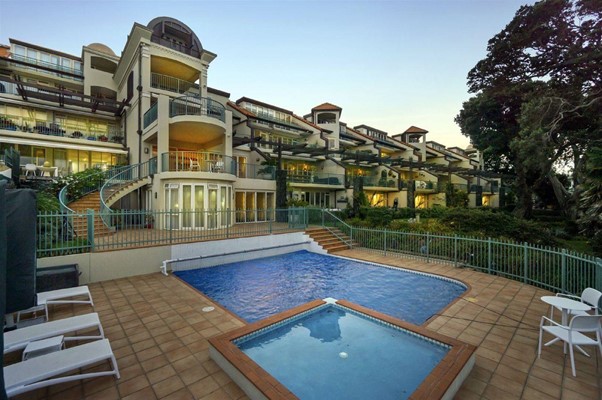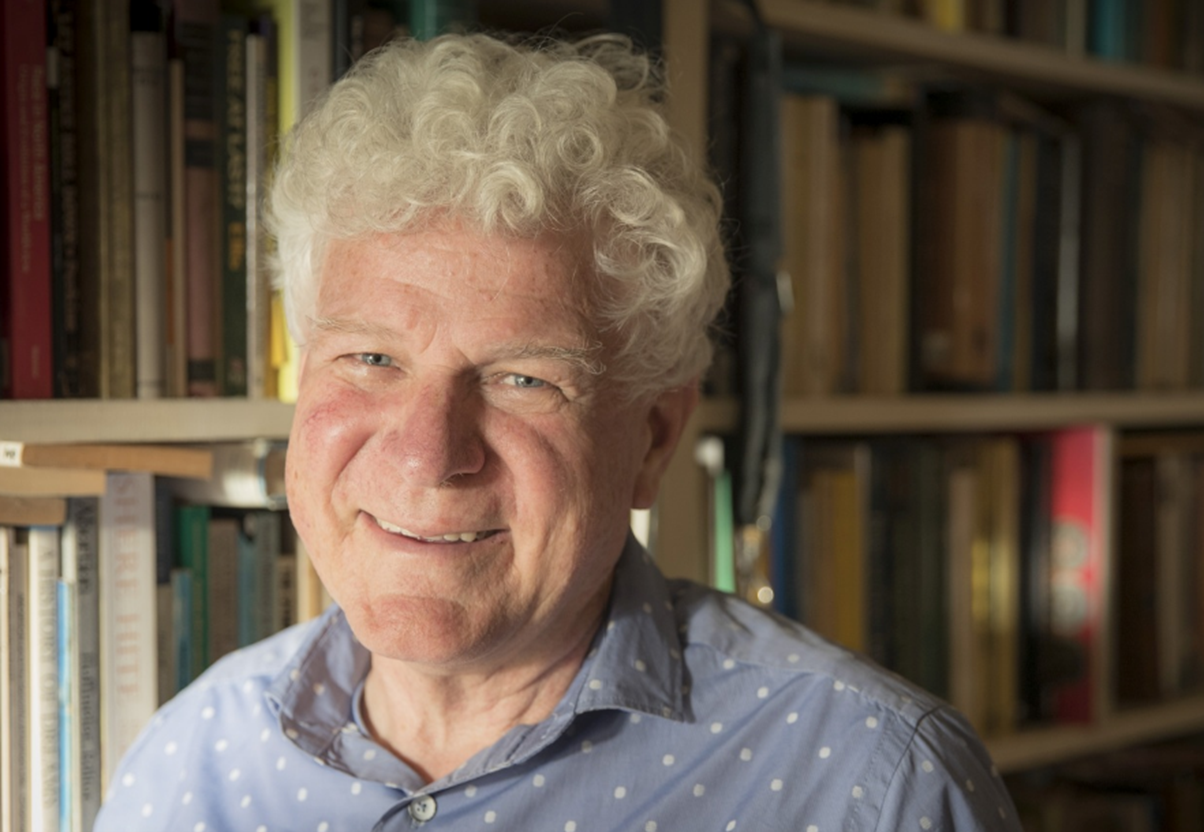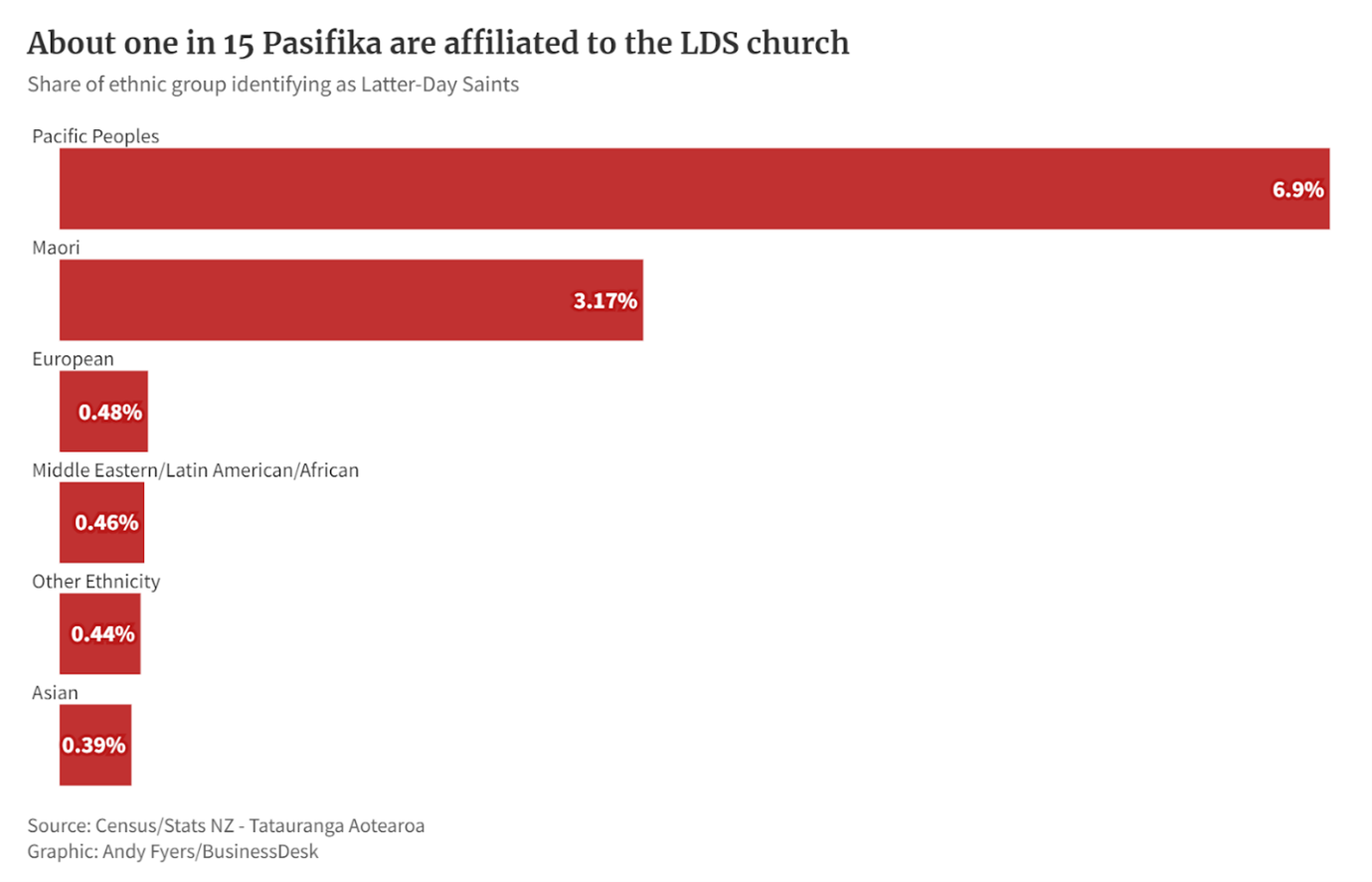Aside from the conversion work of their young missionaries, New Zealand’s Mormon communities are typically insular.
Through interviews with former bishops, members and scholarly experts, BusinessDesk pulls back the curtain on the Church of Jesus Christ of Latter-day Saints.
Additional reporting: Andy Fyers and Greg Hurrell.
If there’s one constant of Mormon life, it’s that you’re kept busy.
On top of a 10% tithe on their gross income, the average Mormon volunteer contributes 37 hours a week to the church, BusinessDesk analysis of the organisation’s filings with the Charities Register reveals.
This is far beyond any other religious organisation.
Even volunteers at the controversy-stricken ARISE Church officially average just over five hours per week, although David Farrier’s reporting has found that interns would regularly complete 12-hour days, at least four times a week.
Unpaid labour
From a religious perspective, this is evidence of members’ devotion to the cause. From a more sceptical point of view, the multibillion-dollar international organisation could be accused of taking advantage of unpaid labour, whilst extracting 10% of their followers’ paid income.
According to multiple sources who’ve spent decades as leaders in the church, these expectations take a huge toll on the membership.
“It makes you time poor, financially poor and kind of wellbeing poor because you're constantly running around for the church. And you do that because otherwise, you're going to hell,” explained Mormon Studies scholar Gina Colvin, who grew up in the church.
Members contribute their time in two main ways: callings and missions.
Missionaries are the white-shirted young (mostly) men on bicycles who go round knocking on doors, seeking to convert new church members. Weekly, they commit up to 60-plus hours of unpaid work, often for up to two years.
In fact, young adults often have to pay more than $10,000 for the privilege because it will often take place abroad, although many are placed around NZ.
This work is voluntary, explained a former Latter Day Saints bishop who grew up in the church during the 1970s and left in his 40s. However, “many consider it essential to go on a mission as a teenager to qualify for the temple and then for the celestial kingdom [Heaven]. So not going on a mission could stop you from going to heaven, there are eternal consequences.”
The former bishop asked to remain anonymous due to “genuine fear” of the blowback his family would receive for revealing the church’s practices. [He will be referred to as AB.].
There are also earthly repercussions for refusing to go on a mission – some young Kiwis have been shunned by their families for saying no.
'Rigid and controlling'
Being a missionary was “the most rigid and controlling time” said AB. “During my two years, most of the aspects of my life were controlled and if I didn't follow I felt guilty and needed to repent.
“This includes how you spend your time, what you wear, where you go and who you are with. I had to be with my assigned companion 24/7. The only exception was going to the bathroom.
“This was so ingrained that when I got home from my mission I found it hard to be in a room by myself.”
He added that many leave the church in their early adult years due to the pressurised culture before and during missions.
Callings, on the other hand, are for all active members and are assigned by the local leader. These could be teaching Sunday School, visiting sick members, leading the choir or organising the youth group – essentially the normal business of running a local church congregation.
Said AB: “Pressure to serve in the church is very high. You do not get paid for callings and this is expected to be done without compensation. The church couldn’t run without it.”
He would regularly commit 20-40 unpaid hours per week in his role while also working full time.
Even parents with lots of young children, which is common because Mormons are explicitly encouraged to procreate, are expected to contribute their free time, as well as their mandatory 10% tithe.
If a member rejected a calling, they may well be considered ineligible for a ‘Temple Recommend’, which is the highest symbol of worthiness in the church.
Those seeking a Recommend must answer 10 questions devised by the First Presidency of the Church.
Among the questions are: “Do you sustain the local leaders of the church?” and “Are you a full tithe payer?”
According to Colvin, this means unless you’ve done everything your local leader has asked of you and consistently paid your tithe, you will not be able to enter the temple.
In the short term, this would mean you couldn't attend your own children’s weddings. More eternally, being without a 'recommend' means you will never achieve salvation.
Pressure to contribute
This intense pressure to contribute money and labour doesn’t take individual circumstances into account and can push members into financial difficulties.
"You're told to pay your tithing first. If it's a power bill or tithing, pay your tithing first, because God will bless you," explained Colvin.
This account was backed up by another former bishop, SC, who also asked to have his name withheld.
This prioritisation wasn’t the result of rogue, pushy local bishops. It is a central message passed down from global leaders.
A passage from the church’s Youth Manual reads: “Pay it first, even when you think you do not have enough money to meet your other needs. Doing so will help you develop greater faith, overcome selfishness, and be more receptive to the Spirit.”
Said AB: “I saw a number of members go into debt so they qualified for a Temple Recommend.
“I was a softer type of leader, but was pressured by my superiors all the time to increase tithing donations.”
Tithing can be paid by handing an envelope with cash or a cheque, along with a tithing slip, to the bishop after Sunday service or via online banking. These would then be deposited into the local BNZ branch that day or on Monday.
Contributions aren’t immediately seen by the bishop but are reviewed during the end-of-year interview when he can see all the tithing deposits and holds the family accountable for what they have donated.
“Every year I would call the families into my office and get them to declare if they were full tithe payers. As the bishop is standing in for Jesus, this is a very high-pressure tactic,” recalled AB.
The potential to squeeze followers for money is particularly striking considering the fact that Mormons are overwhelmingly from the most economically deprived areas of NZ.
More than half (53.6%) of the members come from the 20% of most deprived neighbourhoods in NZ, including a quarter of followers living in South Auckland. But contributing despite hardship is a point of “religious pride”, said Colvin.
“Members who give out of their lower incomes are celebrated publicly, but anecdotally this makes them easy prey for affinity fraud,” she said.
Affinity fraud is where a person is targeted because they are members of an identifiable group.
Those out of work are still expected to give 10% of any unemployment benefits.
A spokesperson for the church did not deny this was the case, adding: “Many members of The Church of Jesus Christ of Latter-day Saints choose to follow the biblical law of tithing. Young and old, wealthy and poor. It is a free-will offering by those who live the law of tithing. I suggest you speak to someone who donates tithes to gain an understanding of how obedience to this divine law is a blessing.”
Affinity fraud
Between 2000 and 2002, many members of the Rotorua Mormon stake were victims of a $15m Ponzi scam run by Lee Papple and her husband Bill. She was an active Mormon herself. She received a five-year jail term and Bill was given two years.
According to Colvin, Papple used her connections within the church and played on the religious benefits of high returns on investment, such as funding grandchildren’s missionary work, to persuade church members to invest.
“These people have been cleared out of all of the savings of everything that they had, and the church said nothing about it at all. It wasn’t even addressed.
"There’s a code of silence around anything bad that Mormons do in public. You don’t air your dirty laundry, even if it means you save people from ruin,” she explained.
The reality of indebted and overworked followers stands in stark contrast to the senior American leaders that are sent over as mission Presidents and regional authorities.
“[They] have all-expenses-paid credit cards, cleaners, nice homes on the North Shore, children’s private school fees paid, all utilities and a comparatively hefty stipend.
“They are typically afforded every comfort – and they do this while poor South Auckland families run the church for free and pay 10% of their income for the privilege,” Colvin said.
For its 200+ paid employees who are based in Takapuna, the church lists $59.47 average hourly earnings.
The church owns at least four upmarket residential properties in Takapuna. Three are apartments at the beachside ‘The Sands’ complex, on The Strand, worth $4.2 million each.
Amenities include a tennis court, gymnasium, heated pool, spa, sauna, beach access and “resort-style manicured and landscaped grounds”. Colvin confirmed Area authorities have stayed in the Strand.
When asked about these apartments, the church responded: “We do not publish addresses of leadership members.”
It is these properties that are said to be the reason for the entire Pacific office, which covers church operations in Australia and 14 Pacific island nations, being based in Auckland.
“When I was working at the office, the Takapuna and Sydney offices merged. There was discussion about whether things should be based in NZ or Australia, but the American leadership at the time would not give up the beachfront apartments.
"The apartments are usually used for the Area presidency who have traditionally been sent from Utah,” said AB.
On this issue, a church spokesperson said the decision was “based on a considered determination of where the best place would be to administer the Church's programs across the entire South Pacific”.
 The pool area at ‘The Sands’, 47 The Strand, Takapuna. The Church of the Latter Day Saints owns three apartments collectively worth $12.7 million. Image: Harcourts Cooper & Co.
The pool area at ‘The Sands’, 47 The Strand, Takapuna. The Church of the Latter Day Saints owns three apartments collectively worth $12.7 million. Image: Harcourts Cooper & Co.
A “large modern luxurious” house overlooking Lake Pupuke, worth $4.1m, is also in the church portfolio. When we asked the church what it was used for, their spokesperson said: “We do not publish information about residential addresses.”
When it comes to expenses for senior leaders, only leaked documents have been able to give an insight.
In 2014, it was revealed that the top-tier leaders, 89 men, received a living allowance of US$120,000 (NZ$189,153) a year, with a consistent 3% annual growth. If that trend continued, it would be around US$152,000 today.
Identity crisis?
Māori have traditionally made up the bulk of the church’s following since the 1880s. The Book of Mormon was first published in te reo Māori in 1889. By 1890, about one in 12 Māori were followers, according to the church.
A number of factors are attributed to this, but both traditions emphasise whakapapa or genealogy and foundational stories based on migrations over large distances by culturally distinct people with divine guardianship.
Māori membership has gradually declined since the 1980s but Pasifika people have supplemented the numbers and by 2018, they made up 48.6% of the NZ Mormon population.
Membership is still a sizable 45.4% Māori. European adherents make up 29.1% of all Mormons nationally. (The census counts people under all the ethnicities they list, so totals exceed 100%.)
Despite this demographic make-up, some members have complained of the Americanisation of the church in NZ with a focus put on Republican party culture war issues such as abortion and LGBTQ+ rights.
When it comes to senior leadership roles, there appears to be a preference for Pākehā, with Americans often imported ahead of local leaders.
The 2018 census reported there were 54,123 Mormons in NZ. The church itself reports 116,883 members nationally – more than double the number that self-identify as church followers via the census.
Four sources that have spoken to BusinessDesk said the official Church of the Latter-Day Saints figures are hugely inflated compared to the real active membership. This is likely due to the practice of keeping every baptised member in its books until death, unless they are excommunicated or remove themselves legally, according to Patrick Mason, the Arrington Chair of Mormon History and Culture at Utah State University.
Some have estimated that the real attendance rate is even lower (around one-third of the church's total) than the census figures.
However, former bishop AB revealed that: “When I was in the Takapuna office the census numbers were very close to weekly Sunday attendance numbers. This indicated to me that most people who consider themselves Mormon attend.”
Peter Lineham from Massey University said: “The membership numbers that the Latter-Day Saints report look very healthy, but this is because it records all the living people who have ever been baptised into the church."
 Peter Lineham of Massey University.
Peter Lineham of Massey University.Lineham said: “The fact is that the church has a drop-out rate of approximately 50% or more from the number baptised. Also, many who remain nominally Mormons have a low level of regular involvement with the church. In this, it is very like many other religious denominations.
“The census figure gives us a level of nominal Mormons but in the 2018 census, up to 15% of the figures were estimates. We won’t know the real level of nominal Mormons until the 2023 census."

“What we do see from the census is that the church has very strong Māori and Pacific groups, plus the remainder is a mix of various ethnicities. This is a very unusual pattern. Māori adherents are in slow decline, Pacific membership continues to grow.
"The huge new temple being erected across the motorway from the Manukau shopping centre shows that the church recognises this group as very important. As for actual attendance, estimates suggest that maybe a third of nominal members attend every Sunday.”
We put a series of questions to the church’s Pacific office. In response, a spokesperson said: “Members of The Church of Jesus Christ of Latter-day Saints in New Zealand and around the world are disciples of Jesus Christ and strive to follow His example, live according to His commandments, and incorporate Christ-like attributes in their daily lives.
“As part of that effort, Latter-day Saints follow the biblical practice of paying tithes and offerings. These funds are used to build and maintain houses of worship, to alleviate poverty, to help individuals become more self-reliant, to support a worldwide missionary programme, to maintain schools in some Pacific countries, and support many other community and humanitarian efforts. The Church follows the law of the land in New Zealand and in all countries in which there are congregations.”
This is the second part of Riches of Heaven, a three-part series in BusinessDesk’s charities' project, made with the support of NZ On Air.
Thursday: The future of the Mormon church















